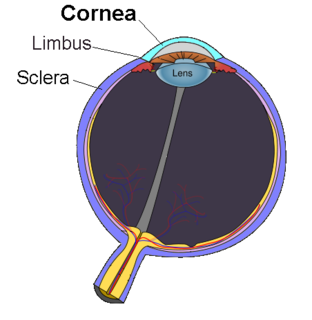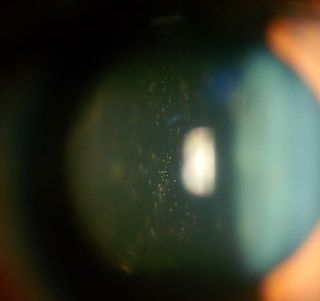
Keratitis is a condition in which the eye's cornea, the clear dome on the front surface of the eye, becomes inflamed. The condition is often marked by moderate to intense pain and usually involves any of the following symptoms: pain, impaired eyesight, photophobia, red eye and a 'gritty' sensation.
This is a partial list of publishes a classification of known diseases and injuries, the International Statistical Classification of Diseases and Related Health Problems, or ICD-10. This list uses that classification.

Uveitis is the inflammation of the uvea, the pigmented layer that lies between the inner retina and the outer fibrous layer composed of the sclera and cornea. The uvea consists of the middle layer of pigmented vascular structures of the eye and includes the iris, ciliary body, and choroid. Uveitis is an ophthalmic emergency and requires a thorough examination by an optometrist or ophthalmologist and urgent treatment to control the inflammation. It is often associated with other ocular problems.

Corneal transplantation, also known as corneal grafting, is a surgical procedure where a damaged or diseased cornea is replaced by donated corneal tissue. When the entire cornea is replaced it is known as penetrating keratoplasty and when only part of the cornea is replaced it is known as lamellar keratoplasty. Keratoplasty simply means surgery to the cornea. The graft is taken from a recently dead individual with no known diseases or other factors that may affect the chance of survival of the donated tissue or the health of the recipient.
Norrie disease is a genetic disorder that primarily affects the eye and almost always leads to blindness. In addition to the congenital ocular symptoms, some patients suffer from a progressive hearing loss starting mostly in their 2nd decade of life, and some may have learning difficulties.

The Meibomian gland is a holocrine type of exocrine gland, at the rim of the eyelid inside the tarsal plate, responsible for the supply of meibum, an oily substance that prevents evaporation of the eye's tear film. Meibum prevents tear spillage onto the cheek, trapping tears between the oiled edge and the eyeball, and makes the closed lids airtight. There are approximately 50 glands on the upper eyelid and 25 glands on the lower eyelid.
ICD-10 is an international statistical classification used in health care and related industries.
A topical anesthetic is a local anesthetic that is used to numb the surface of a body part. They can be used to numb any area of the skin as well as the front of the eyeball, the inside of the nose, ear or throat, the anus and the genital area. Topical anesthetics are available in creams, ointments, aerosols, sprays, lotions, and jellies. Examples include benzocaine, butamben, dibucaine, lidocaine, oxybuprocaine, pramoxine, proparacaine, proxymetacaine, and tetracaine.
Phototherapeutic keratectomy (PTK) is a type of eye surgery that uses a laser to treat various ocular disorders by removing tissue from the cornea. PTK allows the removal of superficial corneal opacities and surface irregularities. It is similar to photorefractive keratectomy, which is used for the treatment of refractive conditions. The common indications for PTK are corneal dystrophies, scars, opacities, and bullous keratopathy.

Punctate epithelial erosions is a pathology affecting the cornea. It is also known as punctate erosive keratopathy or superficial punctate keratitis.

Intermediate uveitis is a form of uveitis localized to the vitreous and peripheral retina. Primary sites of inflammation include the vitreous of which other such entities as pars planitis, posterior cyclitis, and hyalitis are encompassed. Intermediate uveitis may either be an isolated eye disease or associated with the development of a systemic disease such as multiple sclerosis or sarcoidosis. As such, intermediate uveitis may be the first expression of a systemic condition. Infectious causes of intermediate uveitis include Epstein-Barr virus infection, Lyme disease, HTLV-1 virus infection, cat scratch disease, and hepatitis C.

Band keratopathy is a corneal disease derived from the appearance of calcium on the central cornea. This is an example of metastatic calcification, which by definition, occurs in the presence of hypercalcemia.
Chronic progressive external ophthalmoplegia (CPEO), also known as progressive external ophthalmoplegia (PEO), is a type of eye disorder characterized by slowly progressive inability to move the eyes and eyebrows. It is often the only feature of mitochondrial disease, in which case the term CPEO may be given as the diagnosis. In other people suffering from mitochondrial disease, CPEO occurs as part of a syndrome involving more than one part of the body, such as Kearns-Sayre syndrome. Occasionally CPEO may be caused by conditions other than mitochondrial diseases.

Bullous keratopathy is a pathological condition in which small vesicles, or bullae, are formed in the cornea due to endothelial dysfunction.

Corneal dystrophies are a group of diseases that affect the cornea in dogs.
Diffuse lamellar keratitis (DLK) is a sterile inflammation of the cornea which may occur after refractive surgery, such as LASIK. Its incidence has been estimated to be 1 in 500 patients, though this may be as high as 32% in some cases.

Cornea verticillata, also called Fleischer vortex, vortex keratopathy or whorl keratopathy, is a condition characterised by corneal deposits at the level of the basal epithelium forming a faint golden-brown whorl pattern. It is seen in Fabry disease or in case of prolonged amiodarone intake.









